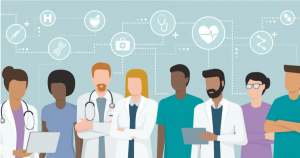Emerging Healthcare Technologies in the Time of COVID-19
Several advantages to telehealth have surfaced as critical during COVID-19.

The pandemic we are currently facing is challenging traditional means of healthcare and highlighting the need for greater capacity for telehealth. In this current and unprecedented moment, the ncIMPACT Initiative aims to keep our partners and stakeholders informed by starting data-driven conversations and connecting you with resources that can boost your work – now more important than ever as COVID-19 continues to spread.

When ncIMPACT sought out new opportunities for improving health outcomes in the state of North Carolina for a recent project, we explored the potential of emerging technologies and methods of data collection in the health arena. Our work included interviewing 25 statewide and national health experts, and our findings continue to surface as relevant. Our experts pointed out several advantages to telehealth that have surfaced as critical during COVID-19.
Telehealth’s Advantages
- Screening patients remotely prevents the need for an in-person Doctor’s visit in which a symptomatic person exposes medical professionals and the public. With a virtual screening, physicians are able to instruct on next steps, including an in person visit with protective procedures if necessary.
- Routine care and check-ins can be provided to those living with chronic illnesses to prevent risking exposure. Many follow-ups and regular appointments can be done via telehealth, aiding in keeping those most vulnerable to complications in their homes.
- Telehealth models protect healthcare workers from coming into contact with as many potentially infected patients. Not only is it a preventative measure, but expands the capacity of providers. As there are less providers able to care for patients due to being infected, telehealth allows the physician to continue working if they choose to do so while quarantined.
- Telehealth will be vital to responding to mental healthcare needs during this time. Our capacity was already strained before COVID-19, and it undoubtedly will face new demands during and after the pandemic. Many people are increasingly facing health challenges and economic challenges, and are often facing these challenges as they are isolating themselves to flatten the curve.

Making Telehealth Work
As more telehealth methods are developed, the community will need to be integrated into the new language and setups of technological systems and data collection methods used by providers. One health expert from our qualitative interviews noted the importance of transparency in order to know what “goal we’re shooting for.” Transparency entails having “conversations with clients, providers, [and] payers,” and making information available to them. To make the technology work for the community, the respondent said, we need to “set up accessible models with a clear sense of what we intend to get out of them.” As many people are shifting to this new model, transparency and communication about telehealth models and the anticipated outcomes is vital to create trust between the patient and the provider.
Barriers to Accessing Telehealth
Telehealth offers many life-saving solutions during a time when person-to-person contact can be potentially deadly. However, we must recognize that these models of healthcare often require access to resources—financial resources to pay for the services if uninsured or uncovered and insurance models that give parity to telehealth services, physical resources (such as a computer) to access telehealth, and connectivity resources to have internet access. For example, North Carolina has a broadband access rate of 68%. This is just one requirement for accessing services, and around 32% of households do not have full broadband access. As we continue to talk about the vitality of telehealth, we must remember that there isn’t equitable access and then work to achieve it.
